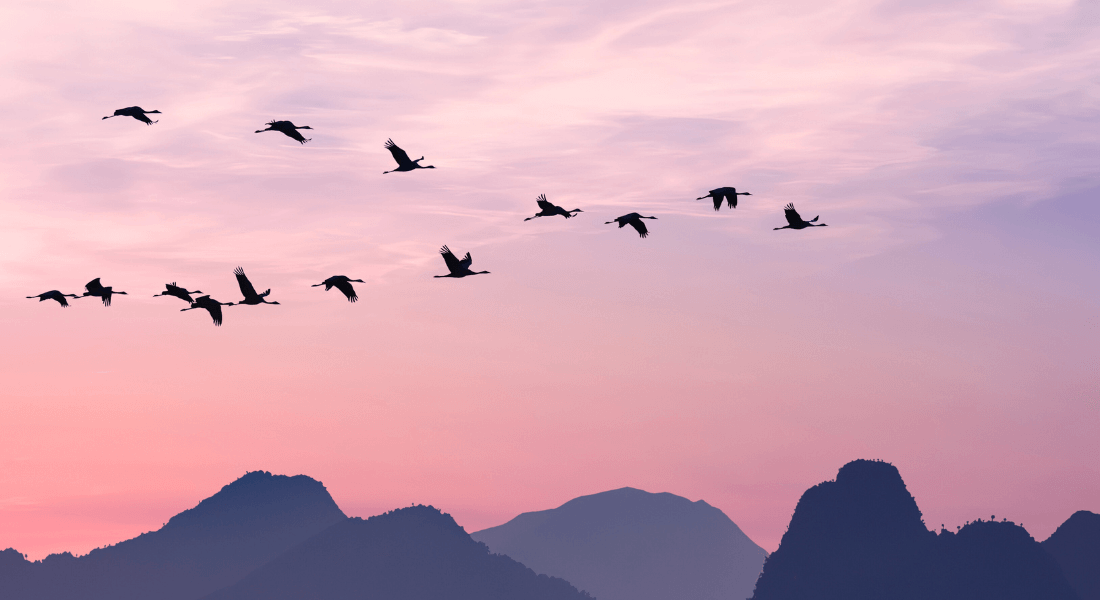Kasper Thorup
Professor
Movement

What is Movement?
Movement is a fundamental process important for resource acquisition and for shaping the spatio-temporal distribution on Earth. Individual movement occasionally leads to longer dispersal events, significantly impacting - and in some cases generating - spatio-temporal patterns of biodiversity. The importance of movement is particularly high in a world that is currently in a state of rapid change.
Our overall research questions
Biodiversity patterns result from the additive effect of movement occurring at multiple spatial and temporal scales, as movement at the individual level scale up to global patterns of biodiversity.
A key focus under the Movement theme is the generation of empirical movement data from living organisms, using various tracking technologies. By providing such data we are able to address certain fundamental questions:
- What factors trigger movement and dispersal at global scales?
- How might movement lead to species persistence or disappearance in a changing world?
- What is the role of humans in the movement of species?
Research projects
Find information and descriptions of some of our research projects within the theme of Movement below.
Most of
Read more about The ICARUS project
The mysteries of long-distance movement
Focusing on long-distance European-African migratory passerine birds we use miniaturized transmitters to elucidate what factors trigger movement at global scales, and determine how exactly even inexperienced young birds on their solitary journeys reach their species-specific winter grounds.
Contact
Professor Kasper Thorup
Dispersal of high Andean birds
Our aim is to determine the mobility of the enigmatic, elusive, and flight-impaired
Contact
Professor Carsten Rahbek
Professor Gary Graves
Professor Kasper Thorup
Aiming at understanding life on the move, we use a variety of tracking and modeling techniques to map and describe movement and migration.
Mapping and modeling songbird migrations
We use light logger technology to track biogeographical spatio-temporal distributions. Until replaced satellite technology, we use miniaturised data loggers to map features of the migration routes and winter grounds of a suite of small passerines wintering in sub-Saharan Africa.
Contact
Professor Kasper Thorup
The role of ocean currents in determining the biogeography of plankton
Many plankton organisms can move. This movement generally promotes resource acquisition but normally (except under low turbulent conditions) does not render the organisms capable of displacing themselves over long distances.
Intuitively, we therefore recognize that water movements must be important in establishing biogeographical patterns in plankton distributions. In these studies, we employ newly adapted modeling approaches to the understanding of the role of water movements in establishing plankton biogeography.
Contact
Professor Katherine Richardson
Senior Researcher Jørgen Bendtsen
Identifying climate change impacts on fish distributions
Fish are among the marine organisms most capable of controlling their own biogeography. Changing patterns in fish distributions have huge impacts on the commercial exploitation of fishes. In these studies, we attempt to understand how climate change may influence the distribution of fishes.
Contact
Professor Katherine Richardson
Guest Researcher Henrik Sparholt
Mapping long distance movement of ticks and tick-borne diseases
Many bird species are tick-infested, and because of their innate migratory behavior, they may contribute significantly to the movement of tick-borne diseases. As part of the EU Horizon2020 project PREPARE4VBD, we aim to assess the role of long-distance migratory birds in the dispersal of ticks and the risk of spreading tick-borne diseases into new environments. We do so by sampling birds caught along the flyway scale and at migratory hotspots in Africa, Southern and Northern Europe.
Contact
Associate Professor Anna-Sofie Stensgaard
Professor Kasper Thorup
Researchers
SENIOR SCIENTISTS
Katherine Richardson
Carsten Rahbek
Gary Graves
Anna-Sofie Stensgaard
Jørgen Bendtsen
POSTDOCS
PHD FELLOWS
Highlighted papers
Thorup, K., Pedersen, L., Fonseca, R., Naimi, B., Nogues-Bravo, D., Krapp, M., Manica, A., Willemoes, M., Sjöberg, S., Feng, S., Chen, G., Rey-Iglesiah, A., Campos, P. F., Beyer, R., Araujo, M. B., Hansen, A. J., Zhang, G., Tøttrup, A. P., Rahbek, C. 2021. "Response of an Afro-Palearctic bird migrant to glaciation cycles". PNAS S 118: e2023836118. Download.
Sjöberg, S., Malmiga, G., Nord, A., Andersson, A., Bäckman, J., Tarka, M., Willemoes, M., Thorup, K., Hansson, B., Alerstam, T., Hasselquist, D. 2021."Extreme flight altitudes during diurnal flights in a nocturnal songbird migrant". Science 372: 646-648. Download.
Thorup, K., Tøttrup, A. P., Willemoes, M., Klaassen, R. H. G., Strandberg, R., Vega, M. L., Dasari, H. P., Araújo, M. B., Wikelski, M. and Rahbek, C. 2017. "Resource tracking within and across continents in long-distance bird migrants". Science Advances 1:17. Download.
Jønsson, K. A., Tøttrup, A. P., Borregaard, M. K., Keith, S. A., Rahbek, C. and Thorup, K. 2016. "Tracking Animal Dispersal: From Individual Movement to Community Assembly and Global Range Dynamics". Trends in Ecology & Evolution Vol. 31, No. 3. Download.

